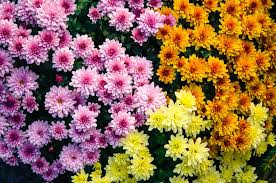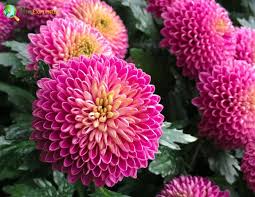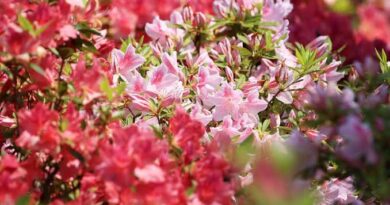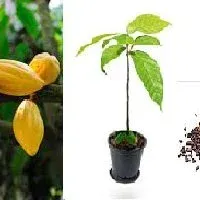Chrysanthemum Flowers (Asteraceae): Complete Growing and Care Guide
Chrysanthemums, commonly referred to as “mums,” are exquisite flowers that have captivated people’s hearts for centuries. Known for their vibrant colors and intricate petal formations, chrysanthemums are celebrated worldwide for their stunning beauty and cultural significance. Whether adorning gardens, bouquets, or art pieces, these magnificent blooms have become a symbol of elegance, longevity, and joy.
Let’s delve into the fascinating world of chrysanthemums and uncover the secrets behind their enduring popularity.
Chrysanthemums belong to the family Asteraceae and are native to Asia and northeastern Europe. They have a rich history dating back over 2,500 years, originating in China, where they were cultivated as a flowering herb. The Chinese were particularly enamored with chrysanthemums, considering them the “Flower of the Sun” due to their radiant colors that mirrored the sun’s warmth and brilliance.
Over time, these flowers were introduced to Japan, where they were highly revered and even designated as the Imperial Seal. Today, chrysanthemums are cherished in many cultures around the globe.
One of the most remarkable features of chrysanthemums is their incredible diversity. With over 40 known species and thousands of cultivated varieties, these flowers offer an astonishing range of shapes, sizes, and colors. From pompons and buttons to daisy-like or spider-like forms, chrysanthemums display an array of intricate petal arrangements that leave observers in awe.
The petals can be single, semi-double, or double, and they come in shades of yellow, white, red, orange, pink, and even purple. Such versatility allows gardeners and florists to create stunning displays and arrangements, tailored to their desired aesthetic.
Aside from their visual appeal, chrysanthemums hold deep symbolic meanings in various cultures. In Japan, the chrysanthemum flower represents longevity, rejuvenation, and the imperial family. It is the national flower and holds great importance during the annual Chrysanthemum Festival. In other parts of Asia, chrysanthemums are associated with honor, loyalty, and friendship.
Furthermore, they are often used in traditional medicine for their believed therapeutic properties, ranging from easing respiratory issues to reducing inflammation.
When it comes to cultivation, chrysanthemums are a joy for gardeners of all levels of expertise. They are generally hardy and can thrive in a variety of climates, making them accessible to a wide range of gardening enthusiasts. Chrysanthemums prefer full sun exposure and well-drained soil.
Their care includes regular watering, occasional fertilization, and pruning to promote bushy growth and enhance flower production. With proper attention, these remarkable plants can grace gardens and provide a burst of color during late summer and fall when many other flowers have faded away.
Chrysanthemums have also found their way into the realm of art and literature. Their striking beauty has inspired countless painters, poets, and artisans throughout history. From delicate watercolor paintings to intricate ceramic designs, chrysanthemums have been immortalized in various artistic mediums, emphasizing their timeless allure and their significance in human culture.
Whether you are an avid gardener, an admirer of nature’s wonders, or someone seeking a meaningful gift, chrysanthemums offer an enchanting choice. With their radiant colors, diverse forms, and rich symbolism, these flowers continue to captivate hearts and stand as a testament to the beauty and resilience of the natural world. So, the next time you come across a chrysanthemum, take a moment to appreciate its grace and elegance—a reminder of the intricate wonders that blossom in our midst.
Read Also: Peony Flowers (Paeonia): Complete Growing and Care Guide
Diversity of Chrysanthemums

The diversity of chrysanthemums is truly remarkable, with a wide range of species and cultivated varieties that showcase an array of shapes, sizes, and colors.
Here are some key aspects of the chrysanthemum’s diversity:
1. Species and Cultivated Varieties: There are over 40 known species of chrysanthemums, including Chrysanthemum indicum, Chrysanthemum morifolium, and Chrysanthemum zawadskii, among others.
These species have served as the foundation for the development of numerous cultivated varieties, resulting in an extensive selection of chrysanthemums available today.
2. Petal Arrangements: Chrysanthemum flowers exhibit various petal arrangements, contributing to their unique appearance. Some chrysanthemums have single petals, with a central disk surrounded by a ring of petals.
Others have semi-double petals, with multiple rows of overlapping petals, while some feature fully double blooms with densely packed layers of petals. The petal arrangements can be flat, spherical, or even spiky, resembling a spider.
3. Shapes and Sizes: Chrysanthemum blooms come in a wide range of shapes and sizes. The flowers can be globular, like pompons or buttons, with compact and rounded forms. They can also be daisy-like, with a prominent central disk and radiating petals. Some chrysanthemums have anemone-shaped blooms, where the central disk is raised and surrounded by a single row of large, showy petals.
Additionally, there are chrysanthemums with decorative or irregular shapes, such as spider chrysanthemums, which have long, slender petals that curl or twist.
4. Color Palette: Chrysanthemums exhibit an extraordinary color palette, encompassing various shades and hues. Common colors include yellow, white, pink, red, orange, and purple. The flowers may have solid, uniform colors or combinations of colors, such as bicolored or multicolored blooms. This diversity allows for endless possibilities when it comes to creating visually stunning displays and arrangements.
5. Growth Habit: Chrysanthemums can have different growth habits, ranging from compact and bushy to tall and upright. Some varieties are low-growing and suitable for borders or ground covers, while others are taller and more suitable for back-of-the-border plantings. This variation in growth habit adds versatility to their use in garden designs and landscaping.
6. Flowering Time: Chrysanthemums are known for their late-season blooms, typically appearing in late summer and autumn when many other flowers have faded. However, there are early-blooming varieties that start flowering as early as spring, providing a longer period of enjoyment. By selecting different chrysanthemum cultivars, gardeners can extend the flowering season and ensure a continuous display of color in their gardens.
The diversity of chrysanthemums offers endless possibilities for gardeners, florists, and enthusiasts to explore and appreciate. Whether it’s the shape, size, color, or growth habit, there is a chrysanthemum variety to suit every taste and purpose. Their remarkable diversity adds beauty, intrigue, and a touch of elegance to gardens, floral arrangements, and artistic endeavors, making them truly captivating flowers.
Read Also: Lily Flowers ( Lilium): Complete Growing and Care Guide
Cultivation and Care

Cultivating and caring for chrysanthemums is a rewarding experience that allows you to enjoy the vibrant beauty of these flowers.
Here are some essential tips to ensure successful cultivation:
1. Sunlight and Location: Chrysanthemums thrive in full sunlight, so choose a location in your garden that receives at least six hours of direct sunlight each day. Adequate sunlight promotes healthy growth and abundant blooms.
2. Soil Preparation: Chrysanthemums prefer well-drained soil with a slightly acidic to neutral pH level. Before planting, prepare the soil by incorporating organic matter such as compost or well-rotted manure. This improves drainage and enriches the soil with essential nutrients.
3. Planting Time: Chrysanthemums are typically planted in the spring, allowing them enough time to establish strong root systems before the blooming season. However, depending on your climate, you may also plant them in early fall to enjoy their late-season blooms.
4. Planting Technique: Dig a hole slightly larger than the root ball of the chrysanthemum plant. Place the plant in the hole, ensuring that the crown (the area where the stems meet the roots) is level with the soil surface. Backfill the hole with soil, gently firming it around the plant. Water thoroughly after planting to settle the soil.
5. Watering: Adequate and consistent watering is crucial for chrysanthemums. Keep the soil evenly moist, but avoid overwatering, as this can lead to root rot. Water deeply when the top inch of soil feels dry. During hot and dry periods, you may need to water more frequently.
6. Fertilization: Chrysanthemums benefit from regular feeding to support healthy growth and abundant blooms. Apply a balanced, slow-release fertilizer in the early spring when new growth begins. Follow the manufacturer’s instructions for application rates. Additionally, you can supplement with a liquid fertilizer every two to three weeks during the growing season.
7. Pruning and Pinching: Pinching or pruning chrysanthemums is essential for promoting bushy growth and increasing flower production. Pinch or prune the stems when they reach about 6 inches in height. This encourages lateral branching and more compact plants. Repeat the process until early July, allowing the plant to focus its energy on bud development.
8. Stake and Support: Depending on the variety and growth habit, some chrysanthemums may require staking or support to prevent bending or damage from wind or heavy rain. Install stakes or plant supports at the time of planting or early in the growth cycle to provide necessary support.
9. Pest and Disease Control: Keep an eye out for common pests such as aphids, leafhoppers, and spider mites. Regularly inspect your plants and take appropriate measures, such as using insecticidal soap or organic pest control methods, if necessary.
Avoid overhead watering, as wet foliage can increase the risk of fungal diseases. Provide adequate spacing between plants to promote air circulation and reduce the chances of disease development.
10. Winter Protection: In colder climates, chrysanthemums may require winter protection. Apply a layer of mulch around the base of the plants before the first frost to insulate the roots and protect them from freezing temperatures. This is especially important for newly planted chrysanthemums.
By following these cultivation and care guidelines, you can enjoy the beauty of chrysanthemums in your garden. Remember to observe your plants regularly, provide them with proper care, and adjust watering and fertilization as needed. With their vibrant colors and stunning blooms, chrysanthemums will bring joy and charm to your outdoor space.
Read Also: Addressing Air Transportation Pollution for a Sustainable Future










